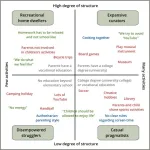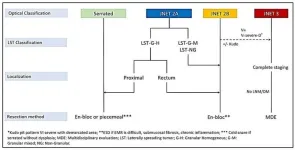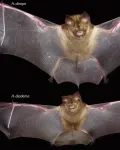(Press-News.org) COLUMBUS, Ohio – Drug effects have dominated the national conversation about psychedelics for medical treatment, but a new study suggests that when it comes to reducing depression with psychedelic-assisted therapy, what matters most is a strong relationship between the therapist and study participant.
Researchers analyzed data from a 2021 clinical trial that found psilocybin (magic mushrooms) combined with psychotherapy in adults was effective at treating major depressive disorder.
Data included depression outcomes and participant reports about their experiences with the drugs and their connection with therapists. Results showed that the stronger the relationship between a participant and clinician – called a therapeutic alliance – the lower the depression scores were one year later.
“What persisted the most was the connection between the therapeutic alliance and long-term outcomes, which indicates the importance of a strong relationship,” said lead author Adam Levin, a psychiatry and behavioral health resident in The Ohio State University College of Medicine.
Past research has consistently found that as mental health treatments changed, a trusting relationship between clients and clinicians has remained key to better outcomes, said senior author Alan Davis, associate professor and director of the Center for Psychedelic Drug Research and Education in The Ohio State University College of Social Work.
“This concept is not novel. What is novel is that very few people have explored this concept as part of psychedelic-assisted therapy,” Davis said. “This data suggests that psychedelic-assisted therapy relies heavily on the therapeutic alliance, just like any other treatment.”
The study was published recently in the journal PLOS ONE.
Twenty-four adults who participated in the trial received two doses of psilocybin and 11 hours of psychotherapy. Participants completed the therapeutic alliance questionnaire, assessing the strength of the therapist-participant relationship, three times: after eight hours of preparation therapy and one week after each psilocybin treatment.
Participants also completed questionnaires about any mystical and psychologically insightful experiences they had during the drug treatment sessions. Their depression symptoms were assessed one week, four weeks, and up to one year after the trial’s end.
The analysis showed that the overall alliance score increased over time and revealed a correlation between a higher alliance score and more acute mystical and/or psychologically insightful experiences from the drug treatment. Acute effects were linked to lower depression at the four-week point after treatment, but were not associated with better depression outcomes a year after the trial.
“The mystical experience, which is something that is most often reported as related to outcome, was not related to the depression scores at 12 months,” Davis said. “We’re not saying this means acute effects aren’t important – psychological insight was still predictive of improvement in the long term. But this does start to situate the importance and meaning of the therapeutic alliance alongside these more well-established effects that people talk about.”
That said, the analysis showed that a stronger relationship during the final therapy preparation session predicted a more mystical and psychologically insightful experience – which in turn was linked to further strengthening the therapeutic alliance.
“That’s why I think the relationship has been shown to be impactful in this analysis – because, really, the whole intervention is designed for us to establish the trust and rapport that’s needed for someone to go into an alternative consciousness safely,” Davis said.
Considering that psychedelics carry a stigma as Schedule I drugs under the Controlled Substances Act, efforts to minimize negative experiences in future studies of their therapeutic potential should be paramount – and therapy is critical to creating a supportive environment for patients, the authors said.
This study ideally will help clearly position psychedelics treatment as a psychotherapeutic intervention moving forward – rather than its primary purpose being administration of a drug, Levin said.
“This isn’t a case where we should try to fit psychedelics into the existing psychiatric paradigm – I think the paradigm should expand to include what we’re learning from psychedelics,” Levin said. “Our concern is that any effort to minimize therapeutic support could lead to safety concerns or adverse events. And what we showed in this study is evidence for the importance of the alliance in not just preventing those types of events, but also in optimizing therapeutic outcomes.”
This work was supported by the Center for Psychedelic and Consciousness Research, funded by the Steven & Alexandra Cohen Foundation, the RiverStyx Foundation and private donors. It was also supported by the Center for Psychedelic Drug Research and Education (CPDRE), funded by anonymous donors.
Additional co-authors are Rafaelle Lancelotta, Nathan Sepeda and Theodore Wagener of Ohio State, and Natalie Gukasyan, Sandeep Nayak, Frederick Barrett and Roland Griffiths of the Center for Psychedelic and Consciousness Research at Johns Hopkins University, where Davis is an affiliate.
#
Contacts:
Adam Levin, Adam.Levin@osumc.edu
Alan Davis, Davis.5996@osu.edu
Written by Emily Caldwell, Caldwell.151@osu.edu; 614-292-8152
END
Do children have regular bedtimes and do parents enforce strict screen time policies? And do parents take their children to museums so that they can learn from an early age? Or is everyday life more about having fun together, without clear rules and any ambition to ‘develop’ children in any particular way?
Family life can be lived in many different ways, and what children bring with them from the home environment has a substantial impact on their opportunities and development later in life.
A new study from the Department of Sociology, University of Copenhagen, and VIVE - The Danish Center for Social Science Research ...
Middle-aged and older adults believe that old age begins later in life than their peers did decades ago, according to a study published by the American Psychological Association.
“Life expectancy has increased, which might contribute to a later perceived onset of old age. Also, some aspects of health have improved over time, so that people of a certain age who were regarded as old in the past may no longer be considered old nowadays,” said study author Markus Wettstein, PhD, of Humboldt University in Berlin, Germany.
However, the study, which was published in the journal Psychology and Aging, also found evidence that the trend of later perceived old age has slowed ...
PITTSBURGH, April 22, 2024 – Atrial fibrillation (Afib), a common type of arrhythmia that is on the rise in people under the age of 65, is more dangerous in this increasingly younger population than previously thought, according to a new study published today in Circulation Arrhythmia and Electrophysiology and authored by physician-scientists at the UPMC Heart and Vascular Institute.
The study, which is among the first to examine a large group of Afib patients younger than 65 in the U.S., found that these younger patients were more likely to be hospitalized for heart failure, stroke or heart ...
Researchers who study Earth’s biosphere tend to operate from one of three scientific cultures, each with distinct ways of conducting science, and which have been operating mostly independently from one another, find the authors of a Perspective published in PNAS on April 19, 2024. SFI Professors Christopher Kempes and Geoffrey West, together with External Professor Brian Enquist (University of Arizona) identify and explain the three cultures, and suggest that reconnecting them could help accelerate ...
Colorectal cancer (CRC) is the second most common cancer in the United States. This highlights the importance of early detection and treatment of precancerous lesions like large polyps. Endoscopy offers a minimally invasive approach to removing these polyps, reducing the need for traditional surgery.
This review, published in eGastroenterology, explores advancements in endoscopic resection techniques, specifically Endoscopic Mucosal Resection (EMR) and Endoscopic Submucosal Dissection (ESD).
Complete removal of large polyps (>10 mm) is crucial to prevent progression to CRC. Piecemeal resection during endoscopic procedures can increase the risk ...
The Speech Accessibility Project, which aims to make automatic speech recognition technology more accessible to people with speech differences and disabilities, is now sharing some of its voice recordings and related data with universities, nonprofits and companies.
The project team is accepting signed data use agreements and one-page proposals for 211 recordings of people with Parkinson’s. The download also includes text of the original speech prompts and a transcript of the participants’ responses. A subset includes annotations ...
DALLAS, April 22, 2024 — Scientific researchers in Missouri and Virginia have been awarded nearly $1.4 million each in grants to study ways to extend the life expectancy and improve the quality of life for children with a transplanted heart. These two research awards mark the latest round of funding for a joint $3 million scientific research initiative between the American Heart Association, celebrating 100 years of lifesaving service as the world’s leading nonprofit organization focused on heart and brain health for all, and Enduring Hearts, the only non-profit organization solely dedicated ...
A University of Melbourne researcher has spotted a rare evolutionary phenomenon happening rapidly in real time in bats living in the Solomon Islands.
Dr Tyrone Lavery reports in a paper published in Evolution that two groups of leaf-nosed bats with vastly different body sizes that were thought to be separate species are an example of a rare type of parallel evolution. Parallel evolution is when different populations living in similar environments evolve similar features independently.
The smaller bat, Hipposideros diadema, is found across its six main islands and many smaller islands. It is ...
The SARS-CoV-2 virus that causes COVID has the unsettling ability of often generating variants of itself. Other viruses also mutate, but as SARS-CoV-2 quickly spread throughout the entire human population during the pandemic, killing millions, the virus’ dynamic evolution posed a serious problem: it repeatedly challenged our bodies’ immune response fighting the virus and hindered the process of getting updated vaccines ready.
Understanding the genetic mechanism fueling SARS-CoV-2’s ability to generate variants can go a long way in keeping COVID at bay. In this study published in Nature Microbiology, researchers at Baylor College of Medicine and collaborating institutions developed ...
Governments in the Mesoamerican Reef region are exploring the use of nature-based solutions to strengthen coral health and societal benefits for coastal communities. A new study led by Stanford researchers in collaboration with scientists from the World Wildlife Fund, the Healthy Reefs Initiative, and others from the Smart Coasts project quantified the outcomes of different watershed interventions to support coral health at regional versus national scales, and identified target areas that could improve both ecosystem and societal benefits nationally and across the region.
The nature-based approaches evaluated as key ...


